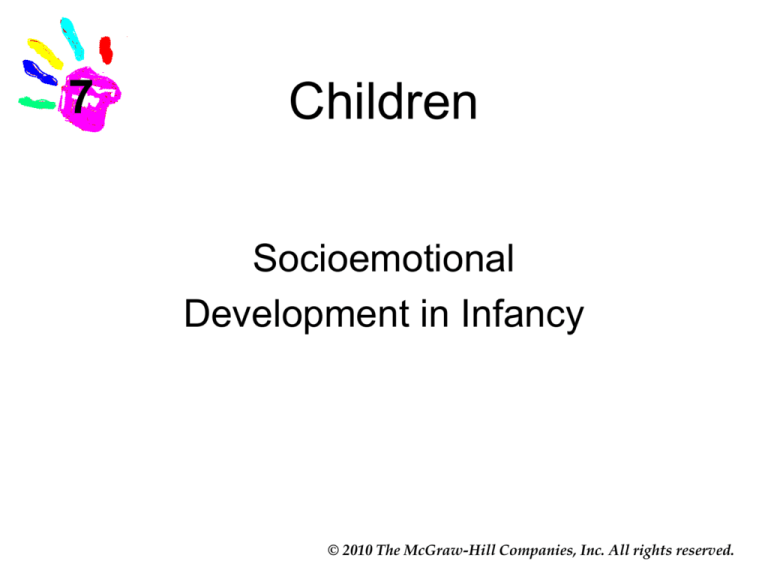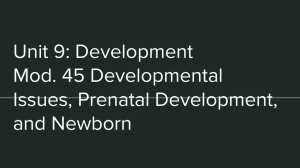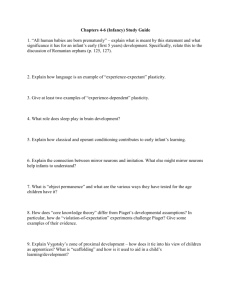
7
Children
Socioemotional
Development in Infancy
© 2010 The McGraw-Hill Companies, Inc. All rights reserved.
Images of Children
• The story of Darius’s fathering
–
–
–
–
Work-at-home father
Extensive father-child interactions
Introduction of child care center
Coordinated careers and child care
© 2010 The McGraw-Hill Companies, Inc. All rights reserved.
Development of Emotions and Personality in Infancy
Emotional Development
• Emotion: feeling or affect of importance
–
–
–
–
–
Complex and varies in intensity
Positive and negative; affects behaviors
Biological influences
Influenced by experiences and culture
Influenced by one’s perceptions
© 2010 The McGraw-Hill Companies, Inc. All rights reserved.
Development of Emotions and Personality in Infancy
Early Emotions
• Primary: present in humans, animals
– Appear in first 6 months of life; surprise, anger,
joy, sadness, fear
• Self-conscious emotions
– Appear after age 18 months; embarrassment,
jealousy, empathy, pride, share, guilt
– Responses to reactions of others
– Research controversy on jealousy in infants
© 2010 The McGraw-Hill Companies, Inc. All rights reserved.
Development of Emotions and Personality in Infancy
Emotional Expression
and Social Relationships
• Two emotional expressions in infant
communication
– Crying
• Basic: rhythmic, incited by hunger
• Angry: excess air in vocal cords
• Pain: louder, high pitched, sudden, longer
– Smiling
• Reflexive: natural, occurs 1 month after birth
• Social: response to external stimuli
© 2010 The McGraw-Hill Companies, Inc. All rights reserved.
Development of Emotions and Personality in Infancy
Fear
• Earliest emotion; appears about 6 months
– Abused, neglected infants show it much earlier
– Stranger anxiety: fear, wariness of strangers
• Intense from 9 to 12 months
• Not shown by all; intensity affected by social
context and stranger behavior/traits
– Separation protest: distress at being separated
• peaks between 13 and 18 months
© 2010 The McGraw-Hill Companies, Inc. All rights reserved.
Separation Anxiety in Four Cultures
African
Bushman
Antiguan
Guatemala
Guatemalan
Indian
Israeli
Kibbutzim
100
80
60
40
20
0
5
10
15
20
25
Age (in months)
30
35
© 2010 The McGraw-Hill Companies, Inc. All rights reserved.
Development of Emotions and Personality in Infancy
Emotional Regulation and Coping
• During first year:
– Gradual control of arousal to adapt, reach goal
– Self-soothing in early infancy
– Redirected attention, self-distraction later in
infancy
– Language defines emotions by age 2
• Contexts affect emotional regulation
– Caregiver responses matter, infant adapts
© 2010 The McGraw-Hill Companies, Inc. All rights reserved.
Development of Emotions and Personality in Infancy
Temperament
• Chess & Thomas: 3 basic types (clusters)
– Easy child: positive mood, easily adapts
– Difficult child: resists change, shows irregular
behaviors, reacts negatively (cries)
– Slow-to-warm child: low mood intensity, low
activity level, somewhat negative
– One-third of children don’t fit into these types
– Temperament: moderately stable in childhood
© 2010 The McGraw-Hill Companies, Inc. All rights reserved.
Development of Emotions and Personality in Infancy
Temperament
• Kegan’s behavioral inhibition
– Extroverted, bold child
– Shy, subdued, timid child
• Inhibited to unfamiliar; shows anxiety,
distress at about 7 to 9 months of age
• Inhibition intensity varies
– Considerable consistency into early childhood
© 2010 The McGraw-Hill Companies, Inc. All rights reserved.
Development of Emotions and Personality in Infancy
Temperament
• Rothbart and Bates’ Classification
– Extraversion/surgency: positive, impulsive
– Negative affectivity: easily distressed
• Kegan’s inhibited child fits here
– Effortful control: self-regulating, control varies
• Overall, don’t pigeon-hole children
– Multiple dimensions of temperament exist
– Context and experiences have impact
© 2010 The McGraw-Hill Companies, Inc. All rights reserved.
Development of Emotions and Personality in Infancy
Biological Foundations and Experience
• Biological influences:
– Physiological characteristics associated with
different temperaments
• Gender, culture, and temperament
• Goodness of Fit and Parenting
– Goodness of fit: match between child’s
temperament and environmental demands
– Siblings differ in response to same parenting
© 2010 The McGraw-Hill Companies, Inc. All rights reserved.
Development of Emotions and Personality in Infancy
Parenting and Child’s Temperament
• Attention to and respect for individuality
• Structuring the child’s environment
• The “difficult child” and packaged
parenting programs
– Flexible caregiver responses
– Avoid “labeling” and self-fulfilling prophecy
© 2010 The McGraw-Hill Companies, Inc. All rights reserved.
Development of Emotions and Personality in Infancy
Personality Development
• Personality: enduring characteristics of
emotions and temperament
• Erikson’s trust-versus-mistrust:
– Infants experience world as either positive or
negative outcomes; continuity not guaranteed
• Sense of self:
– real or imagined; motivating force in life
– Self-recognition: about 18 months of age
© 2010 The McGraw-Hill Companies, Inc. All rights reserved.
Development of Emotions and Personality in Infancy
Personality Development
• The Developing Sense of Self
– Separation and individualization process
• Independence
– Erikson’s 2nd stage: Autonomy versus shame
and doubt
– Self-determination and pride or overcontrol
creates shame and doubt
© 2010 The McGraw-Hill Companies, Inc. All rights reserved.
Development of Self-Recognition in Infancy
Percent of infants who recognized
themselves in a mirror
100
Amsterdam study
80
Lewis and BrooksGunn study
60
40
20
0
9-12
21-24
15-18
Age (in months)
© 2010 The McGraw-Hill Companies, Inc. All rights reserved.
Social Orientation/Understanding and Attachment in Infancy
Social Orientation/Understanding
• Infants motivated to understand the world
– Social orientation: perceptions, interpretations
• Face-to-face play; still-face paradigm
• Different responses to humans and objects;
stronger, positive responses to humans
– Locomotion (crawl, walk, run) independence;
lessens social interactions
– Context and caregiver have effects
© 2010 The McGraw-Hill Companies, Inc. All rights reserved.
Intention, Goal-directed behavior,
and Cooperation
• Important to cognitive development
– Joint attention and gaze: help understand
others’ intentions
• Occurs between 7 to 11 months, intensifies
• Cooperation; connect self-intentions and
those of others (link to social competence)
– Social referencing:
• Ability to ‘read’ emotional cues of others
• Affects infants’ perceptions of others
© 2010 The McGraw-Hill Companies, Inc. All rights reserved.
Social Orientation/Understanding and Attachment in Infancy
Attachment and Its Development
• Attachment; close emotional bond
– Freud:
• Attachment to source of oral satisfaction
• Disproved by Harlow’s research: physical
comfort preferred for security
– Erikson:
• First year is key for attachment, physical
comfort plays role here
© 2010 The McGraw-Hill Companies, Inc. All rights reserved.
24
Mean hours per day
18
.
.
.
.
. .
.
12
.
6
0
Fed by cloth mother
Fed by wire mother
Hours per day spent with
cloth mother
Harlow’s Results:
Contact time with
wire and cloth
surrogate mothers
.
.
.. . .. .. . Hours
per day spent with
wire mother
.
.
1-5
11-10
21-25
6-10
16-20
Age (days)
© 2010 The McGraw-Hill Companies, Inc. All rights reserved.
Social Orientation/Understanding and Attachment in Infancy
Attachment and Its Development
• Bowlby: ethological view - attachment is
innate predisposition
– Attachment: 4 phases of social cognition
• Phase 1; birth to 2 mos. – draws to humans
• Phase 2: 2 to 7 mos. – focus on one person
• Phase 3: 7 to 24 mos. – actively seek regular
contact with caregivers
• Phase 4: after 2 yrs. – aware of others’ goals,
feelings, actions
© 2010 The McGraw-Hill Companies, Inc. All rights reserved.
Social Orientation/Understanding and Attachment in Infancy
Individual Differences in Attachment
• Ainsworth’s Strange Situation
– Measures attachment by observation
– Infant experiences series of contexts
– 3 reactions to new situation
• Secure: positive, confident exploration
• Insecure-avoidant; little interaction with
caregiver, no distress
• Insecure-resistant: clings to caregiver
• Insecure disorganized: disoriented, dazed
© 2010 The McGraw-Hill Companies, Inc. All rights reserved.
Avoidant
Secure
Resistant
70
Percentage of infants
60
Cross-Cultural
Comparison of
Attachment:
50
40
Ainsworth’s
strange situation
applied to infants
in three countries
in 1988
30
20
10
0
U.S.
Germany
Japan
© 2010 The McGraw-Hill Companies, Inc. All rights reserved.
Social Orientation/Understanding and Attachment in Infancy
Differences in Attachment
• Criticisms
– Measures may be culturally-biased
– Lab experiments may not reflect real life
– Early attachment is significant
• Secure linked to high self-esteem, social
competence, self-confidence to
adolescence
• Less continuity for other children
– Infants: resilient and adaptive in life
– Attachment theory ignores diversity
© 2010 The McGraw-Hill Companies, Inc. All rights reserved.
Social Contexts’ Affect On Socieoemotional Development in Infancy
The Family
• Complex, constellation of subsystems
– Reciprocal influences on each other
• The Transition to Parenthood
– New parents must adapt: time, finances, roles
– Marital satisfaction decreases after birth
– Parental cooperation has effect
© 2010 The McGraw-Hill Companies, Inc. All rights reserved.
Social Contexts’ Affect On Socieoemotional Development in Infancy
The Family
• Reciprocal Socialization is bidirectional
– Scaffolding: positive parental behavior
supports children’s efforts
– Children’s skills increase
– Support modified to suit children’s level of
development
– Mothers and fathers both competent
caregivers, but behave differently
– Fathers: more physical in play interactions
© 2010 The McGraw-Hill Companies, Inc. All rights reserved.
Social Contexts’ Affect On Socieoemotional Development in Infancy
Child Care
• Child Care Policies Around the World
– Five types of parental leave
• Maternity leave
• Paternity leave
• Parental leave
• Child-rearing leave
• Family leave
• Europe: leader of new ‘leave’ standards
– Average of 16 weeks, 70% of wages paid
© 2010 The McGraw-Hill Companies, Inc. All rights reserved.
Social Contexts’ Affect On Socieoemotional Development in Infancy
Child Care
• Variations in child care
– Type varies greatly:
• Large centers/elaborate facilities, homes
• Commercial; nonprofit, churches, employers
• Professionals
• Mothers earning additional monies
• Quality matters
– Low-income children: academic benefits
– High quality linked to environment
© 2010 The McGraw-Hill Companies, Inc. All rights reserved.
Social Contexts’ Affect On Socieoemotional Development in Infancy
Child Care
• Patterns of use
– High reliance and early entry
• By 4 months, nearly 3/4 of infants have had
some non-maternal child care
– Socioeconomic factors affect amount and type
• Income level, education, marital status
• Dependence on mother’s income
– Quality affected by group size, caregiver-child
ratio, caregiver (behavior, education, skills)
© 2010 The McGraw-Hill Companies, Inc. All rights reserved.
Social Contexts’ Affect On Socieoemotional Development in Infancy
Child Care
• Amount of child care
– High-quality care and fewer hours in care lead
to positive outcomes
• Family and parenting influences
– Influence not weakened by extensive child
care; parents have significant influence in
children regulating emotions
© 2010 The McGraw-Hill Companies, Inc. All rights reserved.
7
The End
© 2010 The McGraw-Hill Companies, Inc. All rights reserved.








